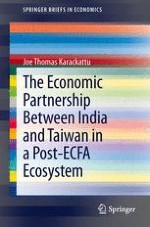2013 | OriginalPaper | Buchkapitel
3. India and Taiwan in a Post-ECFA Ecosystem
verfasst von : Joe Thomas Karackattu
Erschienen in: The Economic Partnership Between India and Taiwan in a Post-ECFA Ecosystem
Verlag: Springer India
Aktivieren Sie unsere intelligente Suche, um passende Fachinhalte oder Patente zu finden.
Wählen Sie Textabschnitte aus um mit Künstlicher Intelligenz passenden Patente zu finden. powered by
Markieren Sie Textabschnitte, um KI-gestützt weitere passende Inhalte zu finden. powered by
